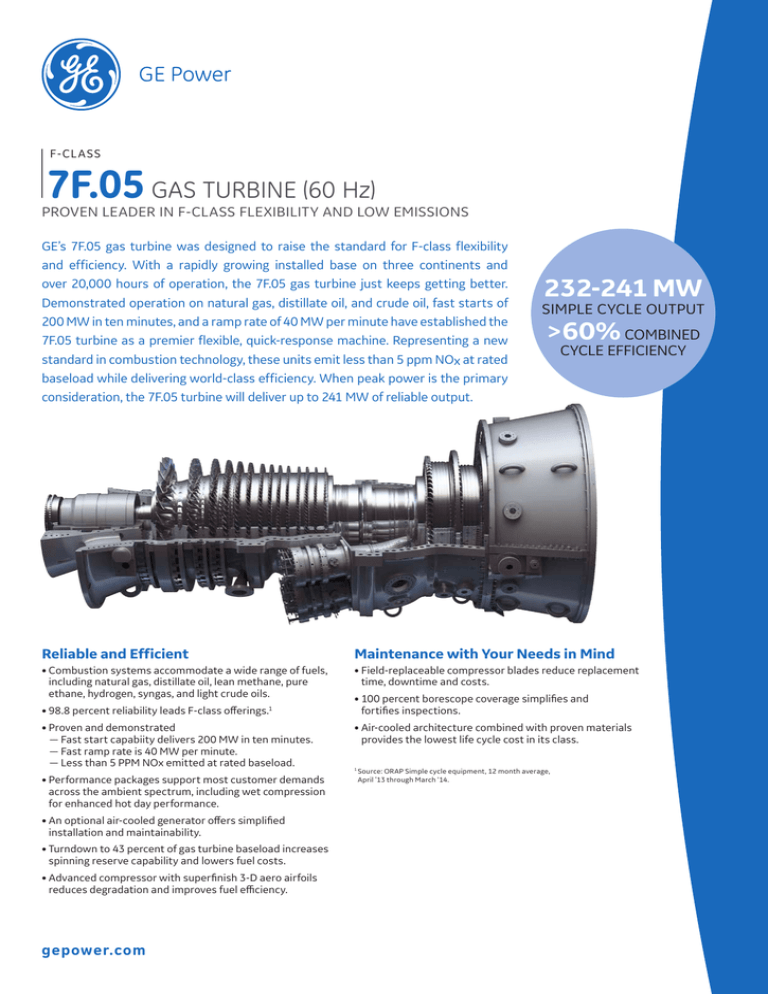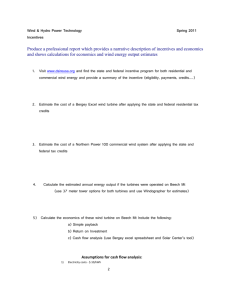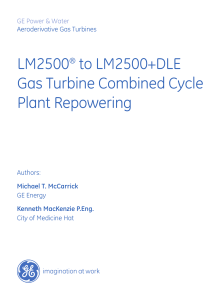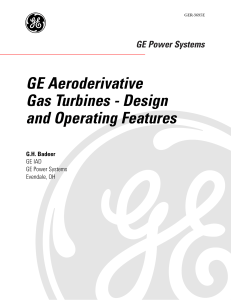
F-CL ASS
7F.05 GAS TURBINE (60 Hz)
PROVEN LEADER IN F-CLASS FLEXIBILITY AND LOW EMISSIONS
GE’s 7F.05 gas turbine was designed to raise the standard for F-class flexibility
and efficiency. With a rapidly growing installed base on three continents and
over 20,000 hours of operation, the 7F.05 gas turbine just keeps getting better.
Demonstrated operation on natural gas, distillate oil, and crude oil, fast starts of
200 MW in ten minutes, and a ramp rate of 40 MW per minute have established the
7F.05 turbine as a premier flexible, quick-response machine. Representing a new
standard in combustion technology, these units emit less than 5 ppm NOx at rated
baseload while delivering world-class efficiency. When peak power is the primary
consideration, the 7F.05 turbine will deliver up to 241 MW of reliable output.
232-241 MW
SIMPLE CYCLE OUTPUT
>60% COMBINED
CYCLE EFFICIENCY
Reliable and Efficient
Maintenance with Your Needs in Mind
• Combustion systems accommodate a wide range of fuels,
including natural gas, distillate oil, lean methane, pure
ethane, hydrogen, syngas, and light crude oils.
• Field-replaceable compressor blades reduce replacement
time, downtime and costs.
• 98.8 percent reliability leads F-class offerings.1
• Proven and demonstrated
— Fast start capabiity delivers 200 MW in ten minutes.
— Fast ramp rate is 40 MW per minute.
— Less than 5 PPM NOx emitted at rated baseload.
• Performance packages support most customer demands
across the ambient spectrum, including wet compression
for enhanced hot day performance.
• An optional air-cooled generator offers simplified
installation and maintainability.
• Turndown to 43 percent of gas turbine baseload increases
spinning reserve capability and lowers fuel costs.
• Advanced compressor with superfinish 3-D aero airfoils
reduces degradation and improves fuel efficiency.
gepower.com
• 100 percent borescope coverage simplifies and
fortifies inspections.
• Air-cooled architecture combined with proven materials
provides the lowest life cycle cost in its class.
Source: ORAP Simple cycle equipment, 12 month average,
April ’13 through March ‘14.
1
SC Plant
Performance
7F.05
(12ppm NOx)
232
241
—
SC Net Heat Rate (Btu/kWh, LHV)
8,610
8,580
—
SC Net Heat Rate (kJ/kWh, LHV)
9,084
9,052
—
SC Net Efficiency (%, LHV)
39.6%
39.8%
—
Exhaust Temperature (°F)
1,122
1,171
1,189
SC Net Output (MW)
Gas Turbine Parameters
605
633
643
Exhaust Energy (MM Btu/hr)
1,209
1,250
1,265
Exhaust Energy (MM kJ/hr)
1,276
1,319
1,335
GT Turndown Minimum Load (%)
46%
44%
43%
GT Ramp Rate (MW/min)
40
40
40
NOx (ppmvd) at baseload (@15% O2)
5
9
12
CO (ppm) at Min. Turndown w/o Abatement
9
9
9
+/-7.5%
+/-7.5%
+/-7.5%
21/11
21/11
21/11
CC Net Output (MW)
—
—
376
CC Net Heat Rate (Btu/kWh, LHV)
—
—
5,660
CC Net Heat Rate (kJ/kWh, LHV)
—
—
5,972
CC Net Efficiency (%, LHV)
—
—
60.3%
Plant Turndown – Minimum Load (%)
—
—
47.9%
Ramp Rate (MW/min)
—
—
40
Startup Time (RR Hot, Minutes)
—
—
25
CC Net Output (MW)
—
—
756
CC Net Heat Rate (Btu/kWh, LHV)
—
—
5,660
CC Net Heat Rate (kJ/kWh, LHV)
—
—
5,972
CC Net Efficiency (%, LHV)
—
—
60.3%
Plant Turndown – Minimum Load (%)
—
—
24.0%
Ramp Rate (MW/min)
—
—
80
Startup Time (RR Hot, Minutes)
—
—
25
Wobbe Variation (%)
Startup Time (Conventional/Peaking, Minutes)
1x CC Plant
Performance
7F.05
(9ppm NOx)
Exhaust Temperature (°C)
2x CC Plant
Performance
7F.05
(5ppm NOx)
Efficient, Flexible, Reliable Power
GE’s portfolio of heavy duty and aeroderivative gas turbines helps
provide a sense of certainty in an uncertain world, delivering
operational flexibility and performance needed to adapt to a rapidly
evolving power generation environment. With gas turbine products
ranging in individual output from 22 MW to 519 MW, GE has a solution
to reliably and efficiently deliver the power needed by utility power
generators, industrial operators, and communities. Even in remote
locations and harsh conditions, you can count on GE to deliver a gas
turbine that will meet your needs.
All of our gas turbines share the common heritage of jet engine
technology pioneered by GE in the first half of the 20th century. They
are typically categorized as either heavy duty (sometimes also called
“frame”) or aeroderivative gas turbines, although some turbines
recently have adopted features of both design types. In general, the
differences between the aeroderivative and heavy duty gas turbines
are weight, size, combustor type, and turbine design. Heavy duty
gas turbines are usually field constructed and maintained in place,
whereas aeroderivative gas turbines are designed to allow for quick
replacement of the entire engine when maintenance is required.
gepower.com
60 Hz Portfolio by Rating
7HA.02
7HA.01
7F.06
7F.05
7F.04
LMS100
7E.03
6F.03
LM6000
6F.01
6B.03
TM2500
LM2500+G4
LM2500+
LM2500
346 MW
280 MW
270 MW
241 MW
198 MW
113 MW
91 MW
82 MW
57 MW
52 MW
44 MW
37 MW
34 MW
31 MW
23 MW
H-CLASS
F-CLASS
E-CLASS
AERODERIVATIVE
© 2015 General Electric Company. All rights reserved.
GEA32225 (11/2015)








